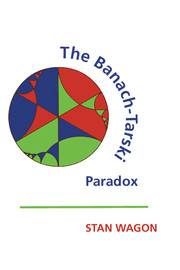Book contents
- Frontmatter
- Contents
- Foreword by Jan Mycielski
- Preface
- Preface to the Paperback Edition
- Part I Paradoxical Decompositions, or the Nonexistence of Finitely Additive Measures
- Chapter 1 Introduction
- Chapter 2 The Hausdorff Paradox
- Chapter 3 The Banach-Tarski Paradox: Duplicating Spheres and Balls
- Chapter 4 Locally Commutative Actions: Minimizing the Number of Pieces in a Paradoxical Decomposition
- Chapter 5 Higher Dimensions and Non-Euclidean Spaces
- Chapter 6 Free Groups of Large Rank: Getting a Continuum of Spheres from One
- Chapter 7 Paradoxes in Low Dimensions
- Chapter 8 The Semigroup of Equidecomposability Types
- Part II Finitely Additive Measures, or the Nonexistence of Paradoxical Decompositions
- Appendix A Euclidean Transformation Groups
- Appendix B Jordan Measure
- Appendix C Unsolved Problems
- Addendum to Second Printing
- References
- List of Symbols
- Index
Chapter 6 - Free Groups of Large Rank: Getting a Continuum of Spheres from One
from Part I - Paradoxical Decompositions, or the Nonexistence of Finitely Additive Measures
Published online by Cambridge University Press: 05 August 2012
- Frontmatter
- Contents
- Foreword by Jan Mycielski
- Preface
- Preface to the Paperback Edition
- Part I Paradoxical Decompositions, or the Nonexistence of Finitely Additive Measures
- Chapter 1 Introduction
- Chapter 2 The Hausdorff Paradox
- Chapter 3 The Banach-Tarski Paradox: Duplicating Spheres and Balls
- Chapter 4 Locally Commutative Actions: Minimizing the Number of Pieces in a Paradoxical Decomposition
- Chapter 5 Higher Dimensions and Non-Euclidean Spaces
- Chapter 6 Free Groups of Large Rank: Getting a Continuum of Spheres from One
- Chapter 7 Paradoxes in Low Dimensions
- Chapter 8 The Semigroup of Equidecomposability Types
- Part II Finitely Additive Measures, or the Nonexistence of Paradoxical Decompositions
- Appendix A Euclidean Transformation Groups
- Appendix B Jordan Measure
- Appendix C Unsolved Problems
- Addendum to Second Printing
- References
- List of Symbols
- Index
Summary
The Banach-Tarski Paradox shows how to obtain two spheres, or balls, from one, and it is clear how to get any finite number of balls: just duplicate repeatedly, lifting the subsets of the new balls back to the original. After all, the joy in owning a duplicating machine is being able to use it more than once. Alternatively, one need only consider the weak system of congruences: A2j ≃ ∪ {Ai: 1 ≤ i ≤ 2n, i ≠ 2j - 1}, j = 1, …, n. By the remarks following 4.12, there is a partition of the sphere into sets Ai that satisfy this system with respect to rotations, and therefore A2j ∪ A2j-1 ∼ S2. Need we stop at just finitely many copies? What about infinitely many, even uncountably many? Using the existence of infinitely many independent rotations (σi τσ-i, i = 0, 1, 2, … where σ, τ are independent), it is not hard to see how the results of Chapter 4 on systems of congruences can be made to yield the solvability of any countably infinite weak system by a partition of S2. Hence S2 can be partitioned into countably many sets, each of which is SO3-equidecomposable (using just two pieces) with S2. But even stronger transfinite duplications are possible. One can get a continuum of spheres from one: the sphere can be partitioned into sets Bα, as many sets as there are points on the sphere (i.e., 2ℵo), such that each Bα is SO3-equidecomposable with the sphere.
- Type
- Chapter
- Information
- The Banach-Tarski Paradox , pp. 73 - 95Publisher: Cambridge University PressPrint publication year: 1985

